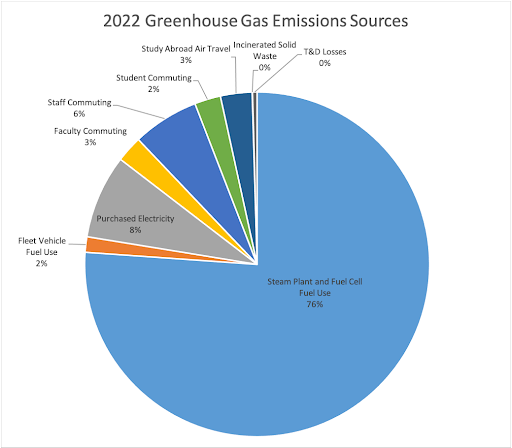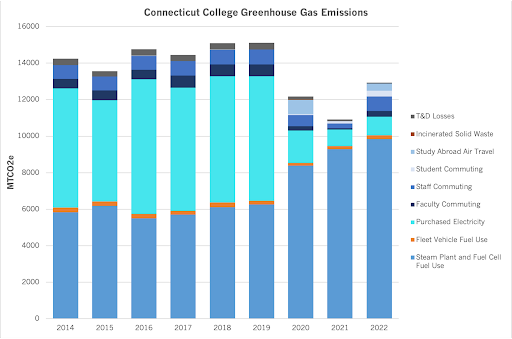Connecticut College publicly committed to achieving carbon neutrality by 2030 on Earth Day 2022. This is an ambitious goal that will require the active participation of all members of our community. Our overarching plan includes three interlocking approaches:
- Reduce energy consumption through behavior change and energy efficiency. Examples of this type of work include LED lighting retrofits, swapping out old mechanical equipment with more energy efficient systems, and educational efforts to reduce plug loads in dorm rooms, offices and teaching spaces.
- Electrify systems that currently run directly on fossil fuels. Since the electrical grid in New England is rapidly greening, and we are adding more renewable electricity generation on campus, replacing systems that directly burn oil and gas will have a huge impact on our emissions. Projects could include replacing oil and gas furnaces with air source heat pumps, encouraging a switch to electric vehicles for our campus fleet and commuters, and ultimately transforming our main campus steam heating system.
- Offset emissions that cannot easily be eliminated. Some commuting, travel and other scope 3 emissions will be hard to reduce since they are based on personal choices and operational needs. These are the emissions that we will target for offsetting through local (when possible),verified carbon offset projects.
What’s Happened So Far
Reduce
In 2022-2023, the College completed over $1 million in energy efficiency projects, exceeding the goal set in the Campus Sustainability Plan. Projects included LED lighting installations in Shain Library, the Plex, 40 renovated classrooms, and all outdoor lighting. In addition, more than 70 steam trap and thermostatic radiator valve repairs were performed. Working with our energy efficiency representative, the College received over $482,000 in incentive awards from Eversource to support these projects, which covered 40% of the cost of these projects.
Our Energy Builders Team works directly with students to reduce their energy use in the residence halls through events, competitions and prizes. Learn more about their work here.
The College is also participating in an Eversource-funded program called Strategic Energy Management that provides technical support, and some financial incentives, for low and no-cost energy efficiency projects on campus. This partnership will last for the next three years.
Previously completed projects have included LED lighting retrofits in the Athletic Center, the installation of variable speed fans in kitchen spaces, and three LEED-certified renovations (New London Hall, the Fitness Center and Silfen Auditorium).
Electrify
Geo-exchange System
When New London Hall was renovated in 2013, a geo-exchange system for heating and cooling was added to the building. This system uses 45 wells drilled 500-ft deep under Tempel Green to change the temperature of water that is pumped into the building’s heating and cooling system. In the winter, the temperature of the Earth warms the water for heating and in the summer the water cools down underground before being pumped back into the building for cooling. The system reduces the energy consumption of heating and cooling the building by 33%.
On-Campus Solar
In 2021, a rooftop solar array was installed on our Service Building. This project was designed, planned and installed by students participating in a class taught by Professor Chad Jones. The array has been exceeding our initial electricity production estimates since it was installed. You can view real-time production on this dashboard.
Air-Source Heat Pumps
Air-source heat pumps were installed in 2022 and 2023 at 33 Gallows, Nichols House, the Service Building and Strickland House. Heat pumps are a very energy efficient source of heating and cooling, allowing us to rely less on oil furnaces, electric baseboards and window air conditioners in these spaces. We expect these projects will save ~2,000 gallons of oil per year at Nichols and the Service Building and 29,000 kWh of electricity at Strickland House. Over half the costs of these projects were covered by Eversource incentives.
Electric Vehicle (EV) Infrastructure
The campus currently has three EV charging stations, each with capacity to charge two cars simultaneously. Two are located across from the Cummings Art Center and are open to students, faculty, staff and the public. One is located in the Admission’s parking lot and is open to visitors to the Admission’s office and to faculty and staff. A fourth charging station, located by Hillel, is currently under repair.
The College has also begun the process of transitioning its own fleet of vehicles to electric vehicles. Two new GEM car small utility vehicles have recently arrived on campus and are currently being used by Facilities trades.
Offset
Connecticut College originally adopted the use of Renewable Energy Certificates (RECs) in the early 2000s, eventually offsetting nearly all main campus electrical emissions, as a way to address carbon emission. Students eventually declared a preference for investments in sustainability initiatives to focus more on concrete steps to reduce energy usage and waste on campus. This change resulted in the formation of the Sustainability Project Fund, which continues to fund sustainability efforts on campus. In the future, the college may reengage in the purchase of RECs as a way to account for carbon emission that cannot be directly eliminated on campus.
Connecticut College was one of the first institutions of higher education to utilize an off-campus carbon offset program to address on campus emissions through a partnership with ReForest the Tropics. The nearly 25-year-old project is nearing completion and the college will be actively looking to adopt future forest offset projects in the future, possibly including an offset program utilizing the campus arboretum.
Upcoming Projects
South Campus Solar Array
The College is currently in the detailed planning phase for a 730 kW ground-mount solar array that will be located at the south end of our main campus. This array will produce electricity equivalent to 7% of our main campus electrical needs. The array will be positioned along a south facing slope adjacent to South Lot in an area currently infested with non-native vegetation. The installation is planned to include wildflower and low meadow plantings under the panels, greatly improving the aesthetics of this area. Work is expected to begin in 2024.
More information on future projects can be found on the Campus Projects page.
Campus Emissions
Our campus greenhouse gas emissions are categorized into three scopes.
Scope 1 includes emissions produced directly from our campus infrastructure and owned assets. For us, this includes the emissions produced from burning natural gas at our steam plant for heating and hot water, emissions from the natural gas used in our on-campus fuel cell for electricity generation, fuel oil and propane burned in furnaces for some of our smaller buildings, and gasoline and diesel emissions from our campus fleet.
Scope 2 includes emissions from purchased electricity. At Connecticut College, this electricity is purchased from our local utility provider Eversource. A small amount of electricity from the grid is used to supplement electrical supply from the fuel cell and solar array for main campus, and grid-based electricity is the only source of electricity for the athletic center and outlying buildings for the remainder of campus operations.
Scope 3 includes emissions that are indirectly caused by campus operations. The emissions from this scope that are included in our carbon neutrality commitment are commuting by students, faculty and staff and travel for business, athletics and study abroad. Emissions related to waste disposal, wastewater, and upstream electrical production are tracked and reported, but are not included in our neutrality goal at this time. Emissions not currently tracked include emissions from purchased goods and services, including food purchases, and investments. It is worth noting that Scope 3 emissions from purchased goods and services are ultimately Scope 1 and 2 emissions from these supply chains. Therefore, steps have been taken and will continue to expand to improve purchasing procedures and vendor choices to reduce these sources of emissions. A good example of this approach includes the decision to eliminate the College purchase of single-use bottled water on campus.
For the purposes of emissions tracking and reporting, we utilize 2014 as our baseline year. Since that year we have achieved a 12% reduction in Scope 1 and 2 emissions.

